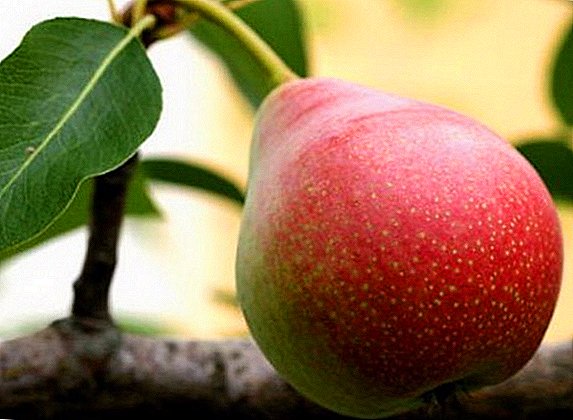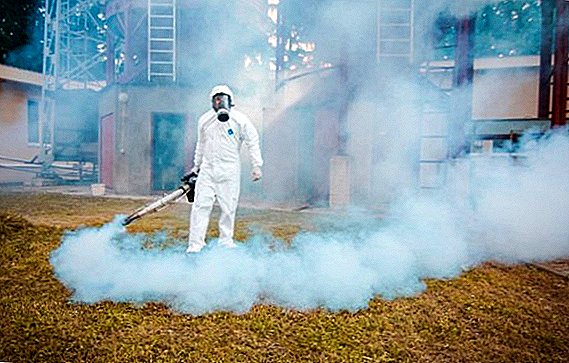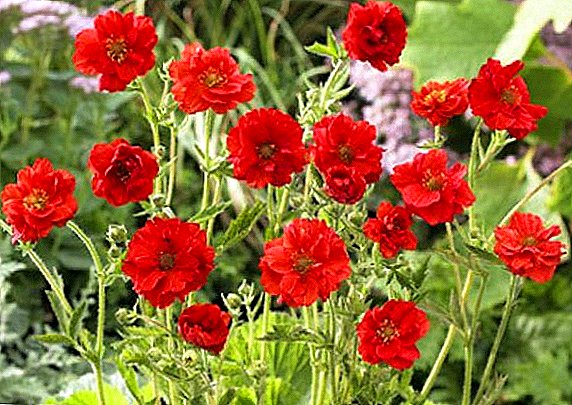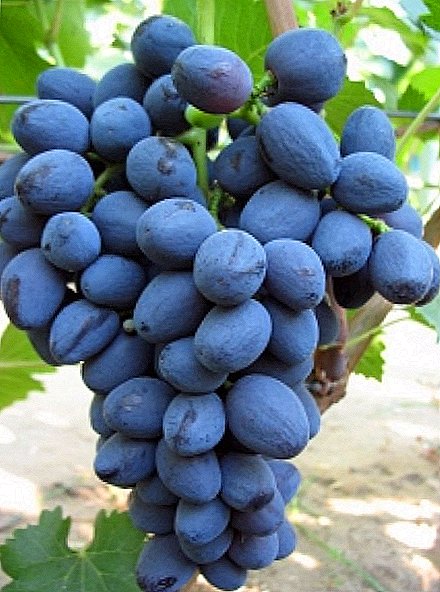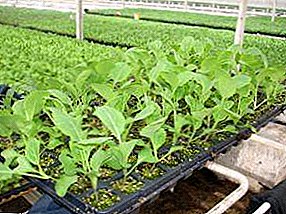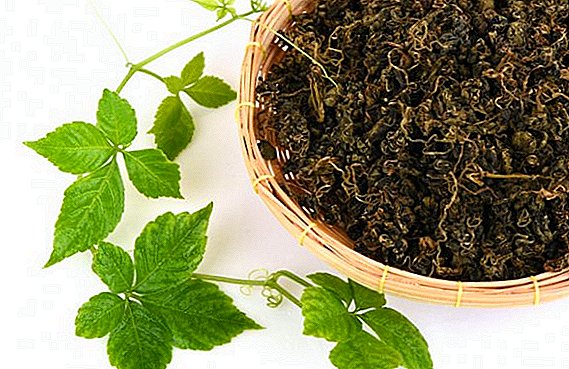 Let's get acquainted with a unique plant that everyone can grow at his country site or in the front garden. It is about the gynostemma of the five-leafed, Chinese culture, which is attributed to the properties of extending a person’s life and which in 1991 was recorded at the conference in Beijing in the top ten tonic herbs. We will tell you how and why to grow this plant, how to harvest medicinal raw materials and cook miracle tea.
Let's get acquainted with a unique plant that everyone can grow at his country site or in the front garden. It is about the gynostemma of the five-leafed, Chinese culture, which is attributed to the properties of extending a person’s life and which in 1991 was recorded at the conference in Beijing in the top ten tonic herbs. We will tell you how and why to grow this plant, how to harvest medicinal raw materials and cook miracle tea.
Botanical description
Guinosthem five-leaf still has several names: herb of immortality, cheap ginseng, jiaogulan. This is a herbaceous climbing vine plant belonging to the same genus and the Pumpkin family. His homeland is China.  The shoots of the gynostemma are thin, with branched tendrils at the end. Can reach lengths of 8-9 m.
The shoots of the gynostemma are thin, with branched tendrils at the end. Can reach lengths of 8-9 m.
Leaves petiolate, palmate, complex. In length reach 8 cm, in width - 3 cm. Grow on long petioles. Have from five to nine lanceolate leaves with jagged edges. In the warm season, they are painted in bright green color, in autumn - in red.
Flowering occurs in July and August. Small flowers of white and greenish color are collected in inflorescences in the form of racemes, which reach a length of 15 cm.
After flowering fruits are formed. These are small, 0.8 cm in diameter, spherical black berries with two or three seeds in the middle.
In appearance, the gynostemma somewhat resembles wild grapes.
Read also about the cultivation of girlish (wild) grapes.
Spread
Gynostemma is widespread in China, India, Malaysia, Vietnam, Korea, Japan, Bangladesh, Sri Lanka and other Asian countries. It grows in forests, among clusters of bushes, on the roadside, occasionally found in the mountains at an altitude of 3000 m above sea level.
 Gynostemma planted in the open ground as a ground cover and covering the vertical surface of the plant. At home, she is also planted in a pot as an ampel culture, while her shoots are drooping down. By the way, when the gynostemma was introduced to Europeans, at first they used it only as a room culture and only after some time were transferred to flower beds in the gardens.
Gynostemma planted in the open ground as a ground cover and covering the vertical surface of the plant. At home, she is also planted in a pot as an ampel culture, while her shoots are drooping down. By the way, when the gynostemma was introduced to Europeans, at first they used it only as a room culture and only after some time were transferred to flower beds in the gardens.
Ampiel plants are decorative representatives of the flora, with hanging shoots and climbing stems that look great in hanging pots and drawers. These are verbena, lobelia, fuchsia, pelargonium, dichondra, petunia.
Chemical composition
The healing properties of the aerial parts of the plant are explained by the rich content of beneficial substances. Doctors have studied it well. The leaves, which are most often used to create medicines, are present:
- amino acids;
- polysaccharides;
- flavonoids;
- saponins.
And vitamins:
- thiamine (B1);
- Riboflavin (B2);
- alpha tocopherol (E);
- ascorbic acid (C).
AND minerals:
- calcium (Ca);
- zinc (Zn);
- magnesium (Mg);
- selenium (Se);
- iron (Fe).
The chemical composition of the vine is somewhat similar to ginseng, but the latter contains much less saponins. For comparison, there are about 80 species in the gynostemma and 26 in ginseng. 
Beneficial features
The following are attributed to ginostemme. healing properties:
- antilipid;
- tonic;
- immunomodulatory;
- sugar lowering;
- antioxidant;
- rejuvenating;
- soothing;
- tonic;
- hematopoietic;
- anti-inflammatory;
- adaptogenic.
Did you know? The top of the most expensive teas in the world includes a ginseng drink called Tienchi ("Tiens"). It sells for $ 17 per 100 grams. It is believed that it is very useful for the human body. To make the drink even more useful, there are gynostemma leaves for it.
Use in traditional medicine
In China, where traditional medicine still enjoys great confidence, the gynostemma has been used as a medicinal plant since the thirteenth century. The Chinese love to brew tea from leaves and believe that it is he who brings longevity. This traditional means of Chinese medicine is primarily advised for physical and emotional stress. Today, grass is included in many dietary supplements and tea blends.  In addition, the plant helps to get rid of a variety of diseases, bring the body to a tone, relax the nervous system, turn on the inhibition of aging processes, improve metabolism, cleanse the body, and establish cell saturation with oxygen.
In addition, the plant helps to get rid of a variety of diseases, bring the body to a tone, relax the nervous system, turn on the inhibition of aging processes, improve metabolism, cleanse the body, and establish cell saturation with oxygen.
Under the beneficial effects of plants fall digestive, immune, nervous, cardiovascular and reproductive systems.
Among the lovers of Eastern medicine, food supplements from ashwagandha are popular for strengthening the nervous, cardiovascular systems, and general healing of the body.
Long-term use of gynostemma-based products as part of complex therapy allows improving the patient’s condition during such diseases:
- diabetes because it has the effect of lowering blood sugar;
- hypertension, due to the ability to stabilize blood pressure;
- obesity, as it promotes the establishment of metabolic processes and the normalization of weight;
- atherosclerosis, because it removes harmful cholesterol from the blood.
Ginosthemma is also used as prophylactic against:
- blood clots;
- malignant tumors;
- development of hypertension;
- stroke;
- heart attack.
 Useful teas folk healers advise drinking to athletes to increase physical activity and endurance, people whose work is associated with mental work, or those who are engaged in heavy physical exertion.
Useful teas folk healers advise drinking to athletes to increase physical activity and endurance, people whose work is associated with mental work, or those who are engaged in heavy physical exertion.
Did you know? In addition to brewing tea, in the Asian cuisine, ginostemma leaves are also used as a sweetener and seasoning for various dishes. The first mentions of this culture describe its nutritional qualities and use in case of hunger or food shortages. They date back to 1406 and are contained in the Chinese treatise "Medical aid for exhaustion."
Tea
For cooking one cup of healthy drink You will need two or three small spoons of crushed fresh leaves, or one or two small spoons of dried leaves. They need to be poured over 250 ml of boiled water cooled for a minute (when pouring boiling water a lot of valuable substances will evaporate) prepared from purified water. Tea will be ready to eat after five minutes. It has a sweet taste with a slight bitterness.
The same leaves can be brewed two more times. However, the preservation of the drink is not subject. For a therapeutic effect, it must be consumed freshly brewed.
It is not recommended to drink a hot drink after four in the evening, otherwise it will be difficult to fall asleep.  Every day you can consume up to one liter of tea. It should be drunk after meals.
Every day you can consume up to one liter of tea. It should be drunk after meals.
Daily tea is shown to people with chronic fatigue, quickly fatigued, having trouble sleeping, residing in stress. Before drinking it every day for any serious illness, you will need to consult a doctor. It is he who must paint the regimen and dosage.
Tea from ginostemma is contraindicated for pregnant, lactating mothers, children up to three years old, and people with individual plant intolerance.
Read also about the benefits and features of drinking tea with sausep.
Growing a five-leaved gynostemma
In the open ground, an exotic culture is planted with seedlings. Seeds are purchased in specialized stores.
Sowing seeds for seedlings
Seeds require some preparation - soaking for a day in warm water. The substrate for planting is prepared from a mixture of humus or compost with sand. You can also purchase a special substrate in the store. The earth is scattered in small pots and seeds are placed in them, deepening by 2-3 cm. It is desirable to cover the pots with a film to create the effect of a mini-greenhouse. Airing will be necessary once a day.
For the growth of seedlings it is necessary to ensure the air temperature at the level of 20-23 ° C. As soon as sprouts appear from the ground, the film should be removed. 
Landing in open ground
For planting seedlings in open ground, you must choose a well-lit area, but one that is not always under the sun's rays. The best conditions for their growth are bright diffused light or partial shade.
Planting is done when the soil warms to a temperature of 14-15 ° C.
Substrate for planting need to take loose, nutritious. It should pass air and moisture well. Seedlings are placed in the landing pit by the method of transshipment.
Support is required for this culture. It is better to plant it near the walls, fences, gazebos, or to build accessories that are convenient for weaving shoots.
Read also about the cultivation of exotic plants at home: arizema, callistemon, cofie, hymenocallis, feijoa, luffa, strelitzia, pomegranate, calamondin, sinadenium, pawpaw.
Watering and moisture
The plant loves moderate regular watering - once in 7-12 days. In the summer - more abundant, but not before waterlogging. In winter, the number and volume of watering will need to be reduced. Drying of the earth coma is undesirable.
When it is too dry outside, it is advisable to spray it with settled water. 
Top dressing and preparation for winter
The first two years of plant feeding will not be needed. It will receive all the necessary substances from the nutrient soil. In the future, in the spring, it will be necessary to mulch it 5-10 cm with a layer of humus or compost. A year later, you can start feeding "Kemira" (30-40 g per bush).
Since the plant is a perennial, then in the winter it will need to be cut under the root, leaving 3-5 cm above-ground parts, and the roots should be well warmed with spruce leaves, dry leaves, and peat. Despite the fact that it is quite cold-resistant, winter temperatures below -15 ° C will not withstand the gynostemma. In the spring, she re-releases the shoots.
Also, the plant can be transplanted for the winter in a pot and placed in a greenhouse or in room conditions.
Important! If the plant is grown in the house, its therapeutic efficacy is somewhat reduced. The greatest amount of valuable substances is contained in vines growing in open ground.
Diseases and pests
The greatest danger to the gynostemma, as a pumpkin representative, is spider mite and melon aphid.  Spider mite and melon aphid Shrinking the leaves and covering them and sprouts with spiderwebs clearly testifies to tick infestation. If time does not begin treatment, the plant can be lost. Since this parasite develops in dry air conditions, it is necessary to spray more often in the summer. Also one of the methods of prevention is to remove weeds, thorough autumn harvesting of dry plant residues and tillage. For treatment using spraying infusion of onion peel (200 g per 10 liters). With a strong infection process drugs based on chloroethanol.
Spider mite and melon aphid Shrinking the leaves and covering them and sprouts with spiderwebs clearly testifies to tick infestation. If time does not begin treatment, the plant can be lost. Since this parasite develops in dry air conditions, it is necessary to spray more often in the summer. Also one of the methods of prevention is to remove weeds, thorough autumn harvesting of dry plant residues and tillage. For treatment using spraying infusion of onion peel (200 g per 10 liters). With a strong infection process drugs based on chloroethanol.
Find out what types of spider mites harm plants, how to deal with spider mites and aphids folk remedies.
With the defeat of melon aphids, the leaves will be covered with spots, curl, and on the bottom of them clusters of harmful insects will be found. The mass invasion of aphids will require spraying "Karbofos."
Of the diseases of the gynostemma can affect:
- Bacteriosis - manifested as brown spots on the leaves. Prevention and treatment is in the treatment of copper oxychloride or Bordeaux mixture.
- White rot - white bloom appears on the leaves, shoots, roots. The affected organs of the plant are removed, the cut sites are sprinkled with crushed coal or rubbed with copper sulphate.
- Root rot - characteristic features: russeting of roots and stems, constrictions on the root system. In order to prevent the disease, it is necessary to remove weeds, plant debris, apply foliar feeding.
- Mealy dew - it is shown by a white mealy raid on leaves. With a strong distribution help treatment with colloidal sulfur, sodium phosphate disubstituted.
 Signs of plant damage from these diseases
Signs of plant damage from these diseasesImportant! If you plan to use the gynostemma for medicinal purposes, it is necessary to prevent contamination by diseases and parasites, since after treatment with leaf preparations it is impossible to use them.
Harvesting and storage of raw materials
Plant leaves for medicinal purposes harvested in summer. They are cut off and dried under a canopy or in a shaded place where direct sunlight does not fall. For two weeks, the raw materials will need to be mixed periodically.
After drying, the leaves should be stored in bags of natural fabrics or glass containers. Dry leaves will retain their healing properties for 12 months.  The guinosthem five-leaf is a unique plant. On the one hand, it has decorative properties and is widely used to decorate areas and as an indoor, greenhouse plant. On the other hand, its medicinal properties have been proven as mainly anti-lipid, antioxidant, tonic and tonic. At the same time, it can be grown in the garden or at a regular cottage, without requiring special care.
The guinosthem five-leaf is a unique plant. On the one hand, it has decorative properties and is widely used to decorate areas and as an indoor, greenhouse plant. On the other hand, its medicinal properties have been proven as mainly anti-lipid, antioxidant, tonic and tonic. At the same time, it can be grown in the garden or at a regular cottage, without requiring special care.


